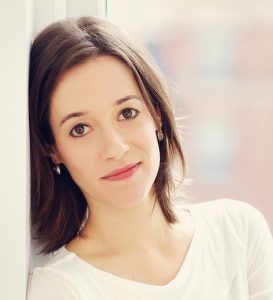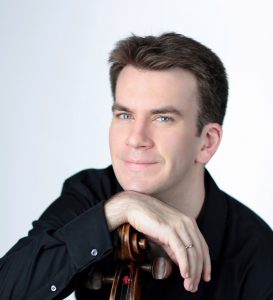Johannes BRAHMS Scherzo in C minor from the F-A-E Sonata, WoO 2 (1853)
Alyssa Wang, violin; Max Levinson, piano
Arnold BAX Oboe Quintet, GP 258 (1922)
Peggy Pearson, oboe; Jennifer Frautschi, violin; Alyssa Wang, violin; Marcus Thompson, viola; Edward Arron, cello
Kevin PUTS And Legions Will Rise (2001)
Romie de Guise-Langlois, clarinet; Alyssa Wang, violin; Ayano Kataoka, marimba
Johannes BRAHMS Piano Trio No. 2 in C major, Op. 87 (1882)
Jennifer Frautschi, violin; Edward Arron, cello; Max Levinson, piano
Featured musicians
Brahms’s Scherzo in C minor is widely considered the gem of F-A-E Sonata, a collaboration between three composers dedicated to violinist Joseph Joachim. It opens with a fiery statement, and while moments of calm lyricism follow, they are continually interrupted by the emphatic opening material. The final iteration of the theme morphs into a surprisingly triumphant ending.
Written between the world wars, Bax’s Oboe Quintet is haunted by darkness and melancholy. The piece opens mysteriously with an improvisatory solo in the oboe before the ensemble launches into an energetic Allegro, featuring a broad palette of tone colors in the strings. The first two movements occupy the same soundscapes as the Irish songs Bax composed earlier, while the finale is an Irish jig.
Scored for violin, clarinet and marimba, And Legions Will Rise by Puts “is about the power in all of us to transcend during times of tragedy and personal crisis,” writes the composer. Upward flutters of notes in the marimba and soaring lines in the violin and clarinet evoke flying, while slower moments give space for contemplation.
Brahms’s Piano Trio No. 2 in C major is a highly compact work that nonetheless traverses numerous emotional spheres, from heroic and passionate to mournful and mysterious. The facility and ingenuity with which Brahms develops the work’s melodic and harmonic material demonstrates the hand of a master at the height of his creative powers.
Full program notes
Johannes Brahms (May 7, 1833–April 3, 1897)
Published posthumously as WoO 2, the Scherzo in C minor was Brahms’s contribution to the F.A.E. (Frei aber einsam – “free but alone”) Sonata, dedicated to violinist Joseph Joachim, and so named for the musician’s personal musical motto. Robert Schumann’s student, Albert Dietrich, supplied the first movement, Schumann the second movement Intermezzo and the finale, and Brahms supplied the third movement scherzo.
It was during a visit in 1853 to Göttingen when Brahms met Joseph Joachim, and would in fact return that summer to spend the summer with the violinist. Joachim encouraged Brahms to engage with the music and person of Robert Schumann, and at the end of September, he met Robert and Clara Schumann at their home in Düsseldorf. The Schumanns were impressed and quite taken with the talented twenty-year old Brahms, who Robert Schumann would expressively describe as “sprung like Minerva fully armed from the head of the son of Cronus” in an essay in the Neue Zeitschrift für Musik the following month. That same month, at Schumann’s behest, Brahms wrote the Scherzo for the sonata.
The movement displays Brahms’s deep attention and indebtedness to Beethoven, most obviously in the short-short-short long rhythmic motive that marks the scherzo—a motive that Brahms incorporated in several works. An even more convincing connection is the move from a (nominal) C minor in the beginning to C major at the end, echoing the tonal game plan of Beethoven’s Fifth Symphony. Brahms’s youthful exuberance informs both the character of the movement as well as the treatment of form. While the scherzo section is in a typical rounded binary form, the second half has a conspicuously contrasting character from the first. The trio changes both key and meter (from 6/8 to 2/4), with a more lyrical violin line, but a quiet triplet rumble in the piano briefly recalls the Beethovenian “fate” motive. Instead of the traditional da capo, Brahms writes out the return to the scherzo and ends the movement with a grandiose C major coda, with thematic material derived from the trio section.
Arnold Bax (November 8, 1883–October 3, 1953)
The Oboe Quintet, scored for oboe and string quartet, is significant as the genre was not well established. Léon Goossens (1897–1988), to whom the work is dedicated, had become principal oboe of the Queen’s Hall Orchestra at age 17, and was wounded in World War I. Goossens returned to the Queen’s Hall Orchestra and gathered increased acclaim in the early 1920s. The Quintet was written very quickly over the span of just a few months at the end of 1922, and embraces Bax’s noted connection with Ireland and Celtic culture. The quintet did not premiere until May 1924, when Goossens and the Kutcher Quartet played it at Hyde Park Hotel in London.
After a solemn chord progression, the first movement opens with a sultry oboe solo. Evoking a Romantic exoticism as it wiggles in and out of G minor, it gives way to a gentle expressive section with arpeggiated lines that languidly descend and ascend against gossamer harmonies in the strings. The improvisatory feeling is marked off by pizzicato in the middle string voices and a repeated anchor of D in the cello. The strings come together to assertively rocket toward an oboe solo that tumbles forward and upward, ending the introduction. The movement proper hums with perpetual motion and a mixture of both bowed and pizzicato articulation in the strings, as the oboe offers a roughly articulated melody. The cello picks up the theme, and Bax then establishes a tension between the aggressive theme and a more cantabile melody, played in both the oboe and viola. A rather sinuous solo oboe line signals a transition to the original tempo, and a tranquil key change. The opening theme returns in the oboe, in duet with the first violin, with muted strings. The languorous lines connect the work back to French Impressionist sensibilities, avoiding pastoral rhetoric often associated with English wind music. The end of the movement is unhurried and pianissimo, with a final utterance of the oboe reaching up to the final G major chord.
The Lento espressivo begins with a somber chord in the low strings, over which a tender theme in the first violin, supported by the rich harmonies of the strings as the oboe remains tacet. The music is pentatonic and nostalgic, evoking a sense of English folksong, with gentle dissonances. An oboe solo unfolds out of the chordal texture, creating a sense of mystery. A clear and simple melody sounds in the viola, accompanied by the cello, but dissolves into a sustained chord underlying another ad libitum passage from the oboe. The movement progresses with these two ideas: a chordal English folk song interspersed with solo utterances from the oboe that act as connective tissue. A return to the original tempo offers a more homophonic approach, although filled with counterpoint that flies under the radar. Bax, whose major successes were mostly symphonic, seems hyperaware of the possibilities for more intimate gesture and nuance in the chamber context. The movement ends much in the same fashion as the first, with an ascent to an E-flat chord, providing a clear moment of tranquility, unfettered by any subtle dissonances or constantly shifting string textures.
Given the general ethos of the first two movements, the pizzicato strumming of the Allegro giocoso is all the more startling, casting the reverie of the other movements away and replacing them with an Irish jig. The delightful skipping dance that ensues is tuneful and falls in line with standard pastoral composition, with much more homogeneity of texture. An energetic secondary theme issues forth in the oboe, against oscillating octaves in the first violin. A homophonic section seems to quote a folk tune before the oboe returns to its more impressionistic meanderings to link to a section more in keeping with the first two movements, but with a soulful melody in the cello. While Bax had taken part in actual jigs, there is no solid evidence that the “folk tune” is extracted from an external source, and the jury is out on whether the melody is a quotation or not. Homophonic strings transition to vibrant triplets in the solo oboe to move to a Vivace section that Bax marks pianisssimo and “senza espressione”—an interesting inversion of the common rhetoric of “faster and louder”. The mysterious change in affect is brief, however, and the oboe quickly returns to the main theme of the movement. Bax is not complacent, however, and ushers in a rather martial sounding section, before one last nod from the oboe to the languor of the first movement, and a last rush of vivace toward the final chord.
Kevin Puts (Born February 22, 1961)
Kevin Puts won the 2012 Pulitzer Prize for his first opera Silent Night, and has garnered a variety of awards and acclaim. His more recent opera of 2022, The Hours, had its staged premiere at the Met, featuring Kelli O’Hara, Joyce DiDonato, and Renée Fleming. Puts has composed across the full gamut of genres, including symphonies, concertos, choral music, solo, and chamber music. His works have been commissioned and performed by Jeremy Denk, the Los Angeles Chamber Orchestra, the Atlanta Symphony Orchestra, the Baltimore Symphony Orchestra, Conspirare, and the Miro Quartet, to name just a few. In addition to the Pulitzer, Puts received two awards from the American Academy of Arts and Letters, a Guggenheim Fellowship, the Rome Prize, as well as many other honors. Currently a professor of composition at the Peabody Institute since 2006, Puts received his Bachelor’s and DMA degrees from Eastman School of Music, and his Master’s Degree from Yale University.
And Legions Will Rise was commissioned by the Kobe Shinbun Newspaper and premiered in October 2001 in Kobe, Japan, performed by Yayoi Toda (violin), Todd Palmer (clarinet), and Makoto Nakura (marimba). Puts has this to say about the work:
“Composed in the summer of 2001, And Legions Will Rise is about the power in all of us to transcend during times of tragedy and personal crisis. While I was writing it, I kept imagining one of those war scenes in blockbuster films, with masses of troops made ready before a great battle. I think we have forces like this inside of us, ready to do battle when we are at our lowest moments.“
Johannes Brahms (May 7, 1833–April 3, 1897)
At age 49, Brahms was in the “interregnum” (to quote Walter Frisch) between his second and third symphonies, and returned his focus to chamber music: 1882 saw both the Op. 87 Piano Trio and the String Quintet No. 1 in F major, 1886 brought out the Cello Sonata No. 2 in F major, the Violin Sonata No. 2 in A major, and the Piano Trio No. 3 in C minor. The Violin Sonata No. 3 in D minor and the String Quintet No. 2 in G major followed in the next four years. Having at last tackled two symphonies, Brahms returned to chamber music with renewed gusto, evident in his exploitation of sonority and thematic invention which was economized by motivic relationships between themes. Certainly that is relevant here, where Brahms provides a general gameplan of joining the two strings as a unit (often playing in octaves or thirds), contrasted with the piano in melodic gestures and counterpoint. Of course there is much more to it than that, but the overall cohesion of the piece is striking, especially given its liberal approach to form and abundance of thematic material in both the outer movements. Brahms, who was well-known as one of his own harshest critics, uncharacteristically wrote to his publisher: “You have not yet had such a beautiful Trio from me and very likely have not published one to equal it within the last ten years.”
The C major Allegro boasts several interrelated themes, the first of which is forthrightly delivered in octaves in the violin and cello before broadening to all three instruments. The piano enters conspicuously on the offbeat, creating a hemiola exchange with the strings within the triple meter. Brahms capitalizes upon the strong gestural language of the theme, and a series of articulated octaves bring the energy back down to introduce the contrasting dolce theme in the piano. The cello acts as a go-between with its upper arpeggiations then melting into a tender duet with the violin. Descending triplets in the strings offer a motive that builds as it transfers to a passionate swell with the piano, and these swells appear in the movement almost as a formal element. Graceful pizzicato dotted rhythms in the cello establish a melodic pattern that is then bowed in augmented quarter notes in the violin. A quiet rumbling of triplets in the piano undergirds smooth quarter notes in the strings, then the roles switch, emphasizing Brahms’s general vision for the instruments. A return of thematic material is heard in the coda, with a final celebration of the opening theme in the closing measures.
By contrast to the thematic complexity of the first movement, the second movement Andante con moto offers a relatively straightforward theme with five variations. While each variation is consistently twenty-seven measures long, Brahms does not just rely on the theme’s melody, but also pulls rhythmic ideas from both the melody and the accompaniment in his variations. The theme is strongly articulated and tuneful, with syncopated offbeats in the piano. In A minor, the first variation offers a more subdued melodic variation with the strings in unison as the piano responds with more expressive filled out passages. Variation 2 extracts a motive, heard first in the piano: sixteenth-sixteenth-dotted eighth, which is a variation on the original theme’s quarter-sixteenth-dotted eighth. The strings enter powerfully in the third variation, filling in the theme, with the piano playing an inversion (of sorts) of the opening gesture before it follows suit. Contrast of key is provided by the penultimate variation in A major, as it recalls the rhythmic formula of the opening, with the cello on the onbeat marked gently by offbeats in the piano. The final variation keeps a quiet guise with una corda in the piano, but the tempo returns to the original Andante. The cello offers a new rhythmic configuration of the theme, echoed in the violin, and now almost sorrowful compared to its original version. The music extends out of the fifth variation, carrying the elegiac feeling into the short coda.
The C minor Scherzo opens with a nervous battery of pianissimo sixteenth notes, repeated in the strings, followed by ascending scalar motions. The theme is balanced with more melodic material, and Brahms diversifies the rhythmic and melodic material in all three instruments. Descending cascades in the piano lead toward the C major Trio, which Clara Schumann did not evidently care for upon review of some draft, saying it seemed “not quite important enough and rather manufactured.” Scholarship disagrees as to whether or not Brahms revised the trio after Schumann’s advice (she praised many other aspects of the work). The cello and piano’s left hand articulate the second half of the trio theme, answered by the violin, before becoming rather symphonic in texture. The grandiosity settles back down for the return of the scherzo, which ends rather perfunctorily with a pizzicato chord.
Clara found the finale to be “lively and interesting” and these are both apt descriptions. Formally, the Allegro giocoso is enigmatic: episodic like a rondo, thematically controlled within a loose sonata form, but full of twists and turns of flashy virtuosic passages and quiet rhythmic intensity, not to mention elements of variation. As in the first movement, there are multiple thematic ideas, but all of them relate back to the main theme. In keeping with the quiet of the scherzo, the opening of the movement is marked mezza voce, for a more dramatic impact when the theme comes in full throttle. An extended exchange of staccato eighth notes between the strings and piano offers a moment of relative stasis before culminating in a forte that leads back to pianissimo, with a lyrical theme played in unison in the strings. The legato thematic material supplants a more folksy traditional series of staccato thirds in the cello, and the multiple characters do indeed keep things “lively.” As the end nears, both the violin and cello travel near the upper and lower limits of their respective ranges in contrary motion, as the piano utilizes a wide range of the keyboard with emphatic chords (the hands also in contrary motion).
© 2024 Rebecca G. Marchand









